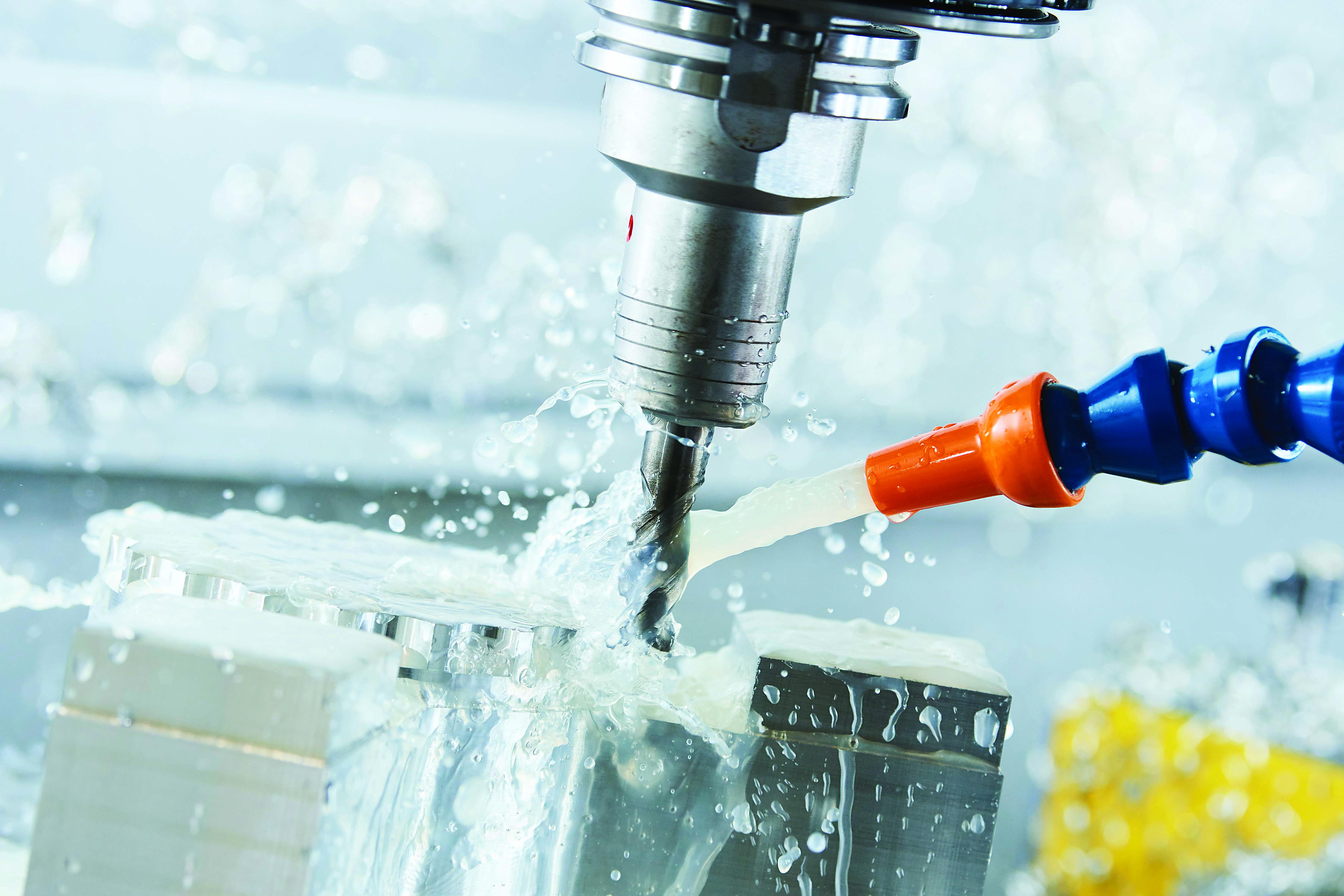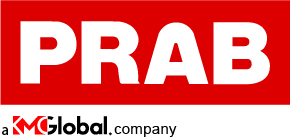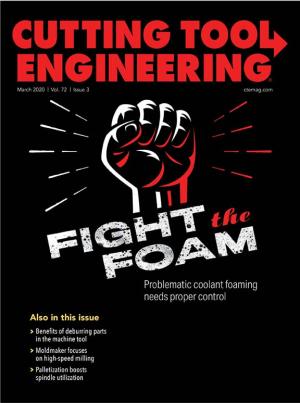Metalworking operations looking to strengthen their bottom lines may want to explore ways to get the most service out of cutting tools.
How effectively a parts manufacturer manages cutting tools can impact profit margins, especially during times of challenging market conditions, such as when material costs are high, interest rates are rising or there’s a recession. Companies that maximize tool life position themselves for more profitable operations over the long run. One key to tool longevity is maintaining best practices for coolant management.
Although purchasing high-quality cutting tools is an important first step to maximize tool life, it’s not the only consideration. Coolant purity also plays a major role in overall tool life.
By preventing tools from exceeding critical temperature ranges during machining, coolant performs a pivotal function. However, cutting fluids are subject to deterioration over time as they become contaminated with tramp oils, metal fines and bacteria. If coolant deteriorates to the point where its lubricity becomes ineffective, tools dull prematurely, break frequently and fail to meet part tolerances for surface finish and size.
Further, as coolant breaks down, it damages not only machine tools but pumps, sumps and even electronic components. Machine parts and interiors become vulnerable to rust and corrosion, equipment surfaces suffer from abrasion, and tramp oil mist causes mechanical failures and prematurely clogs air filters.

Keeping coolant clean through automated coolant recycling systems has been shown to extend tool life by up to 25% or more. Image courtesy of Prab
Automated Coolant Recycling
Continuously monitoring coolant to ensure that it meets the manufacturer’s recommended concentration level is the most important parameter for extending tool and coolant life. However, testing coolant, adjusting coolant concentration levels and treating contaminated coolant with biocides requires time and attention that could be allocated to activities that add value to parts.
Coolant recycling equipment automates the management of coolant quality by separating solids from liquids and removing free-floating and mechanically dispersed contaminants, including tramp oils and bacteria. These systems also automatically adjust fluid concentration for fluid recovery.
Clean, recycled coolant reduces sump maintenance, improves part quality and prolongs tool life. Case studies have shown that tool life can be extended by up to 25% with effective coolant recycling equipment. For example, a manufacturer of metal aerospace components installed a Prab Guardian coolant recycling system at its facility in the Pacific Northwest. The plant used Fuchs Ecocool water-soluble coolant with a total sump capacity of 16,277 L (4,300 gal.). When the manufacturer began automating the filtration of its cutting fluid through the centralized coolant recycling system, average tool life at the facility increased dramatically:
Drills — 209%
Turning tools — 78%
Forming tools — 66%
Boring tools — 47%
Reamers — 26%
The aerospace manufacturer realized additional machining benefits. Surface finish improved by 27%, and tool resharpening costs were cut in half. Machine downtime also decreased by 50%.
Advantages of automated fluid recycling extend beyond tools. Coolant filtration and recycling systems significantly reduce fluid purchase costs and lower hazardous waste disposal costs. These systems are shown to extend coolant two to five times compared with typical change-out periods. Automated systems also eliminate unfortunate byproducts of dirty coolant, such as foul odors and dermatitis.
Equipment Overview
Presented here are eight common types of fluid recycling and filtration equipment.
1. Centralized coolant recycling systems remove tramp oils and suspended solids from contaminated coolant, control bacteria and adjust fluid concentration for fluid recovery.
2. Standard and magnetic paper bed filters can extend tool life by an average of 27%, improve surface finishes and prolong coolant life by removing solids and other debris from free-flowing industrial process liquids.
3. Magnetic separators employ high-intensity ferrite or rare earth magnets in a fully energized, rotating drum to continuously remove ferrous particles from the flow of liquid, which can reduce machine downtime by up to 50%.
4. Drum-type scraper separators extend tool life and provide cleaner surface finishes through high-quality separation of aluminum, nonferrous and composite materials.
5. Solid bowl centrifuges prolong coolant and tool life and help impart fine surface finishes by providing high-performance liquid and solid separation for all types of particles, including metallic, ferrous, nonferrous and nonmetallic solids.
6. Vacuum filtration systems extend tool life by eliminating the high sludge volume produced in machining centers and grinders.
7. Candle filters prolong tool life by removing fine particulates from spent oil in honing, EDMing and tungsten-carbide tool and steel ball grinding applications.
8. Tramp oil separators automatically remove free-floating and mechanically dispersed tramp oils, bacteria, slime and inverted emulsions from machine sumps, central systems and wash tanks.
Back-end equipment solutions enable plants and shops to take control of coolant management and maximize the service life of tools. Unfortunately, shop managers sometimes reject investments in back-end improvements because of leeriness about equipment acquisition costs or because back-end equipment doesn’t translate into a direct expansion of production capabilities. But managers need to keep in mind that taking a proactive approach to operational improvements helps reduce financial strains during challenging market conditions. Investing in capital equipment that lowers costs sets the foundation for a more sustainable long-term growth strategy.
Contact Details
Related Glossary Terms
- boring
boring
Enlarging a hole that already has been drilled or cored. Generally, it is an operation of truing the previously drilled hole with a single-point, lathe-type tool. Boring is essentially internal turning, in that usually a single-point cutting tool forms the internal shape. Some tools are available with two cutting edges to balance cutting forces.
- centers
centers
Cone-shaped pins that support a workpiece by one or two ends during machining. The centers fit into holes drilled in the workpiece ends. Centers that turn with the workpiece are called “live” centers; those that do not are called “dead” centers.
- coolant
coolant
Fluid that reduces temperature buildup at the tool/workpiece interface during machining. Normally takes the form of a liquid such as soluble or chemical mixtures (semisynthetic, synthetic) but can be pressurized air or other gas. Because of water’s ability to absorb great quantities of heat, it is widely used as a coolant and vehicle for various cutting compounds, with the water-to-compound ratio varying with the machining task. See cutting fluid; semisynthetic cutting fluid; soluble-oil cutting fluid; synthetic cutting fluid.
- cutting fluid
cutting fluid
Liquid used to improve workpiece machinability, enhance tool life, flush out chips and machining debris, and cool the workpiece and tool. Three basic types are: straight oils; soluble oils, which emulsify in water; and synthetic fluids, which are water-based chemical solutions having no oil. See coolant; semisynthetic cutting fluid; soluble-oil cutting fluid; synthetic cutting fluid.
- ferrite
ferrite
Solid solution of one or more elements in body-centered cubic iron. Unless otherwise designated, for instance, as chromium ferrite, the solute is generally assumed to be carbon. On an equilibrium diagram, there are two ferrite regions separated by an austenite area. The lower area is alpha ferrite and the upper area is delta ferrite. If there is no designation, alpha ferrite is assumed. Not more than 0.04 percent carbon can be dissolved in alpha iron. Ferrite is stable below 1,670º F (910º C); it is soft, highly ductile, and magnetic. Ferrite loses its magnetic property above 1,414º F (768º C).
- grinding
grinding
Machining operation in which material is removed from the workpiece by a powered abrasive wheel, stone, belt, paste, sheet, compound, slurry, etc. Takes various forms: surface grinding (creates flat and/or squared surfaces); cylindrical grinding (for external cylindrical and tapered shapes, fillets, undercuts, etc.); centerless grinding; chamfering; thread and form grinding; tool and cutter grinding; offhand grinding; lapping and polishing (grinding with extremely fine grits to create ultrasmooth surfaces); honing; and disc grinding.
- lubricity
lubricity
Measure of the relative efficiency with which a cutting fluid or lubricant reduces friction between surfaces.
- metalworking
metalworking
Any manufacturing process in which metal is processed or machined such that the workpiece is given a new shape. Broadly defined, the term includes processes such as design and layout, heat-treating, material handling and inspection.
- recovery
recovery
Reduction or removal of workhardening effects, without motion of large-angle grain boundaries.
- tramp oil
tramp oil
Oil that is present in a metalworking fluid mix that is not from the product concentrate. The usual sources are machine tool lubrication system leaks.
- turning
turning
Workpiece is held in a chuck, mounted on a face plate or secured between centers and rotated while a cutting tool, normally a single-point tool, is fed into it along its periphery or across its end or face. Takes the form of straight turning (cutting along the periphery of the workpiece); taper turning (creating a taper); step turning (turning different-size diameters on the same work); chamfering (beveling an edge or shoulder); facing (cutting on an end); turning threads (usually external but can be internal); roughing (high-volume metal removal); and finishing (final light cuts). Performed on lathes, turning centers, chucking machines, automatic screw machines and similar machines.



